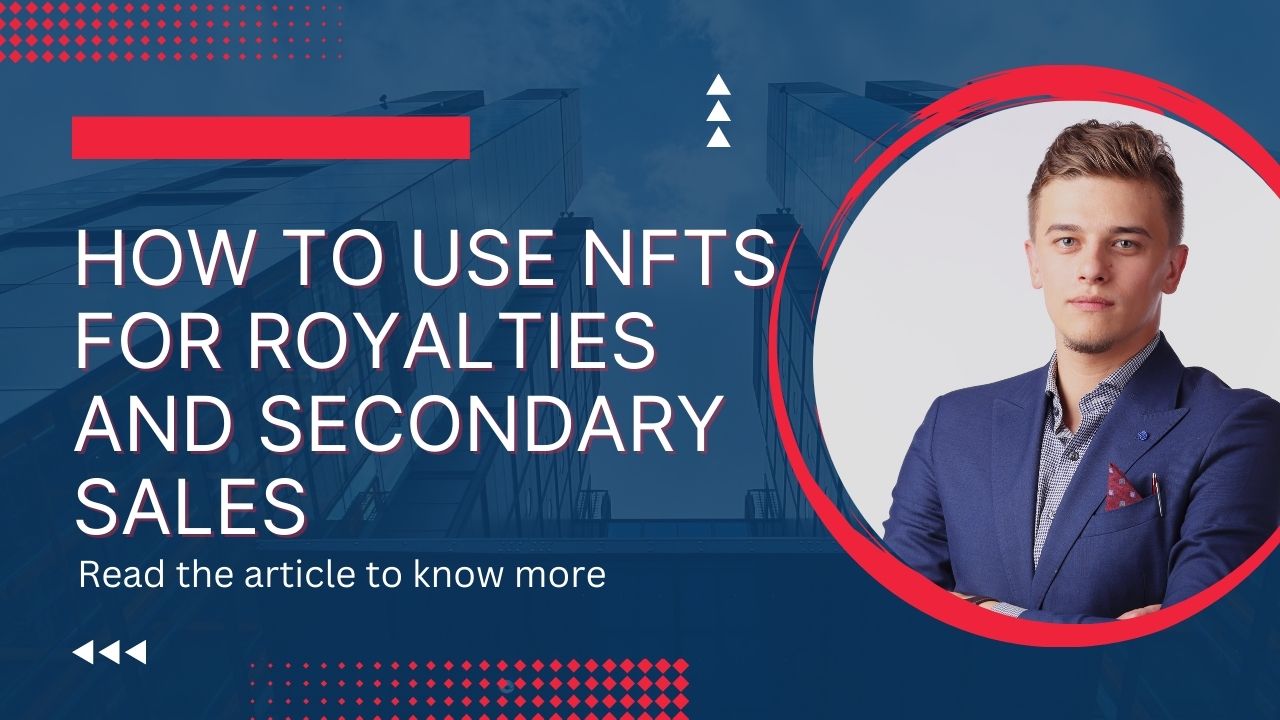Have you ever heard of NFTs? Non-fungible tokens are the talk of the town in the art world, with millions of dollars exchanging hands for digital art that exists solely in a virtual space. However, NFTs aren’t just a craze for collectors and artists; they can also provide a unique way to generate income and royalties for creators in various industries. In this article, we will explore how NFTs can be used for royalties and secondary sales, providing a new revenue stream for creators and transforming the way we think about ownership and value in the digital age.
Briefly explain what NFTs are.
NFTs, or non-fungible tokens, have gained attention recently as a result of their rising ubiquity in the market for digital collectibles and art. A blockchain is a decentralized digital ledger that stores unique digital assets and transactions, and in essence, an NFT is one of these unique digital assets. NFTs are perfect for creating and exchanging unique digital assets since they are one-of-a-kind, unlike typical cryptocurrencies like Bitcoin that can be exchanged for one another.
One of the most exciting developments in the world of NFTs is the idea of using them for royalties and secondary sales. Traditionally, artists and creators have struggled to earn a fair share of the profits when their work is resold on the secondary market. However, with NFTs, creators can embed smart contracts into their digital assets that automatically trigger a royalty payment to the original creator every time the asset is resold.
In conclusion, NFTs are a revolutionary technology that is transforming the way we think about digital ownership and creativity. With the ability to earn ongoing royalties and create unique, one-of-a-kind digital assets, NFTs are sure to continue their meteoric rise in popularity in the years to come.
Understanding NFT royalties
In the world of digital art and collectibles, the term “royalties” has taken on a new meaning with the rise of NFTs. Unlike traditional royalties, which are paid to artists and creators for the use of their intellectual property, NFT royalties are designed to ensure that artists continue to earn money each time their artwork is sold or resold.
In the world of NFTs, royalties work a bit differently. When an artist creates an NFT, they can set a royalty percentage that will be automatically paid to them each time the NFT is sold or resold. This means that even if the NFT increases in value over time, the artist will continue to earn money from it.
One key difference between NFT royalties and traditional royalties is that NFT royalties are built into the blockchain. This means that they are automatic and cannot be ignored or circumvented. Additionally, because NFTs are unique and cannot be replicated, there is no risk of piracy or unauthorized use of the artwork.
Overall, NFT royalties represent a new and exciting opportunity for artists and creators to earn a fair share of the value generated by their work. By leveraging blockchain technology and unique digital assets, NFTs are helping to reshape the world of art and collectibles and ensuring that creators are able to benefit from the full value of their creations.
Using smart contracts for royalties
Smart contracts are self-executing computer programs that automatically enforce the terms of an agreement between parties. When combined with non-fungible tokens (NFTs), they offer a powerful tool for managing royalties in the digital world. Smart contracts are encoded with the terms of the royalty agreement, such as the percentage of revenue to be paid to the creator, the frequency of payments, and the conditions under which payments will be made.
By using smart contracts, royalty payments can be automated, eliminating the need for intermediaries and reducing the risk of errors or disputes. The smart contract executes automatically, ensuring that payments are made accurately and on time. This allows creators to focus on their work rather than worrying about payment processing.
One of the key benefits of using smart contracts for royalty payments is transparency. The terms of the agreement are encoded into the smart contract, and all parties can see the terms and the payment history. This creates trust and eliminates the possibility of disputes over payment amounts or timing.
Another benefit is cost savings. With smart contracts, there is no need for intermediaries such as agents, publishers, or record labels, which can significantly reduce the cost of managing royalties. Additionally, smart contracts can be programmed to handle complex payment structures, such as revenue sharing between multiple creators or payment splitting across different platforms.
The use of smart contracts for royalty payments offers numerous benefits, including automation, transparency, and cost savings. As more creators adopt NFTs and explore new ways of monetizing their work, smart contracts will likely become an essential tool for managing royalties in the digital world.
Secondary sales of NFTs
In recent years, Non-Fungible Tokens (NFTs) have taken the art and collectibles world by storm, offering a new way to authenticate and trade unique digital assets. While many NFTs are sold by their creators or primary marketplaces, a growing trend is the emergence of secondary markets, where NFT owners can resell their tokens to other collectors and investors.
The secondary market for NFTs is a fascinating ecosystem, where the value and appeal of different tokens are constantly shifting based on supply, demand, and the whims of the market. Some NFTs increase in value over time, thanks to their rarity, historical significance, or popular appeal. Others may see their value plummet if their creators or associated projects fall out of favor, or if too many similar tokens flood the market.
One of the most interesting aspects of secondary NFT sales is the potential for new revenue streams for artists, musicians, and other creators. By setting up royalty structures or smart contracts that automatically generate income from secondary sales, creators can benefit from the appreciation of their work overtime, even if they only receive a one-time payment from the initial sale.
FAQs
What is a secondary market for NFTs?
A secondary market is a marketplace where NFTs can be resold by their current owners. Secondary sales can generate additional royalties for the creators of the NFTs, as well as for any other parties who have included royalty terms in the smart contracts.
How do NFT royalties work in practice?
Whenever an NFT is sold on a secondary market, the smart contract automatically calculates and distributes the specified royalty payments to the creators and other parties involved.
What are the benefits of using NFTs for royalties?
NFTs provide a transparent and secure way for creators to earn ongoing income from their digital content, without relying on intermediaries or centralized platforms. They also enable fans and collectors to own and trade unique digital assets with confidence.
Who can create NFTs?
Anyone can create NFTs, as long as they have a digital file to represent their content and access to a blockchain platform that supports NFTs. Some popular platforms for creating and selling NFTs include OpenSea, Rarible, and SuperRare.
What are some examples of NFTs?
NFTs can represent a wide range of digital content, including artwork, music albums, virtual real estate, game items, tweets, memes, and more.
How do I buy or sell NFTs?
To buy or sell NFTs, you need to create an account on a blockchain platform that supports NFTs, connect a digital wallet that holds cryptocurrency, browse the available NFTs, and make an offer or purchase using cryptocurrency.
What are the risks of using NFTs for royalties?
NFTs and blockchain technology are still in their early stages and subject to technical, regulatory, and market risks. As with any investment, it’s important to do your research and understand the risks before participating in the NFT market.
Also read:
How to Use NFTs for Digital Identity and Verification
How to Use NFT Marketplaces for Buying and Selling
How to Use NFTs for Gaming and Collectibles
Conclusion
In conclusion, NFTs have become a ground-breaking technology that empowers creators to claim ownership of and profit from their digital creations. NFTs give writers, performers, and other creators the ability to receive royalties and profit from further sales of their works by utilizing the blockchain’s capacity. Whether you’ve been creating for a while or are just getting started, embracing NFTs can present you with a range of unrivalled chances to monetize your digital works and build relationships with fans and collectors all around the world. NFTs are expected to be a key factor in determining the direction of digital ownership and creativity as the digital landscape continues to change.

Neelam is a talented writer and financial analyst, currently studying at Hansraj College. She is a regular contributor to Trickyfinance, where she covers a range of topics including price prediction, stock market news, and market analysis. Neelam’s passion for finance and economics led her to pursue a writing career in the financial industry, where she has gained valuable experience and insights into the workings of the market. In her free time, Neelam enjoys reading and conducting her own market analysis to stay up-to-date with the latest trends and developments in the industry.




